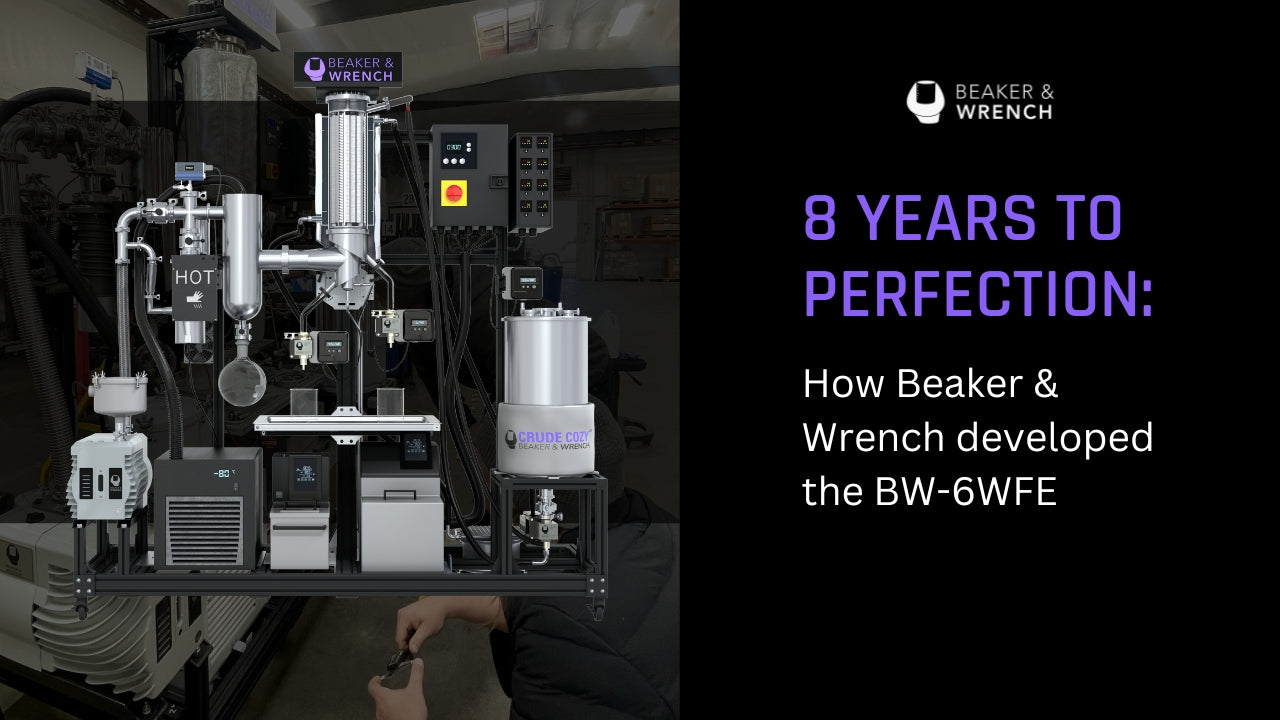The BW-6WFE was the first large scale industrial oil refinement system I developed at Beaker & Wrench. Developing the BW-6WFE turnkey system wasn’t always a straight line. It’s been a journey of incremental improvements, unexpected challenges, and countless hours of dedication. My first exposure to the ancillary side of cannabis was in 2016 when I first developed the Peristaltic Dosing Pump to replace a valve that would consistently clog on a two-inch distillation system. Vanessa de la Puente (my co-founder) and I had no idea this project would evolve into our first turnkey system.
From a Single Dosing Pump to a Complete System
The Peristaltic Dosing Pump was initially developed because my co-founder, Vanessa de la Puente was working at the first licensed lab in Berkley CA, and was having clogging issues with the distillation system she was managing. After expressing frustration with the clogging of the machine, I began to brainstorm a way to push the thick oil smoothly through the wiped film system. My solution was to build and retrofit a pump that would apply heat so the oil was distilled out easier. This was the birth of the Peristaltic Dosing Pump.
We continued to sell the peristaltic dosing pump and eventually began to spec complete systems. It was common for us to spec glass units and retrofit these units with our peristaltic dosing pump, our PID controllers, our own circulators, dosing systems, and more. I traveled to assemble wiped films for two years before it became exhausting and tedious. This whole time the idea for our own wiped film setup was brewing in my head. We had already developed a line of our own retrofittable products so naturally, the next logical step was to develop our own custom wiped film evaporator.
Addressing the Challenges of Assembly and Logistics
I began to think about the criteria that I wanted for the wiped film. With a wide range of experience assembling wiped films, I knew that our design had to focus heavily on optimizing the user experience. This wasn’t about flashy features; it was about the small, practical details that would make the system easier and more enjoyable to use. This focus shaped many of my final design decisions. For example, we wanted to ensure that the unit would fit through as a standard door while ensuring convenient access to the discharge ports. This ensured that the user did not have to awkwardly maneuver around the equipment.
I decided I wanted the unit to fit on a lift gate and be built on a single frame. The team would meticulously measure the dimensions of standard delivery trucks to ensure the system would fit easily so we could eliminate the logistic nightmare of having to unpack and set up a full system when I traveled to install at a lab. The move to a single, fully integrated frame represented a significant improvement. By pre-assembling components on the frame, the system became significantly more user-friendly and quicker to ship.
One of the most significant upgrades was integrating Huber circulators, which offered better temperature control and bulletproof reliability. We also reworked the electrical system, replacing multiple outlets with a single connection point—eliminating setup headaches. Even small details, like switching to a heated transfer hose instead of using heat tape, made a meaningful impact on usability.
The integration of the feed tank is another example of design focused on user experience. Based on previous experience with similar systems, we positioned the feed tank for easy access and straightforward operation. It is a feature that seems obvious now but wasn’t initially a standard practice in the industry.
The system was designed with a focus on streamlining the overall workflow, not just the chemical processes. This reflected our commitment as a company to provide our clients with a user-centered turnkey system.
Continuous Refinement: The Path to the Final Product
The development of the BW-6WFE wasn’t a single breakthrough but an ongoing process of refinement. Each iteration built on the last, with the team constantly improving efficiency, reliability, and ease of use.
These incremental improvements, layered over eight years, resulted in a system that’s more than just a collection of components—it’s a fully realized, user-centric design. Every decision, from optimizing the feed flask position to designing a frame that simplifies shipping and installation, reflects our commitment to creating an intuitive, hassle-free system.
The BW-6WFE stands apart because of these small, thoughtful refinements from the feed valve to the vacuum manifold. It’s not about flashy features but the everyday experience of the people using it. The final product is a seamless, highly efficient system built with the user in mind—proof that real innovation comes from continuous learning and improvement, not just one big idea.




Leave a comment
All comments are moderated before being published.
This site is protected by hCaptcha and the hCaptcha Privacy Policy and Terms of Service apply.